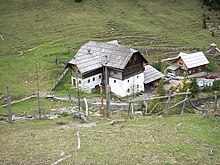Karlbad
The Karlbad is an old farmer's bath in Carinthia , which is considered the last of its kind in the Eastern Alps .
The Karlbad property is located at 1,693 m above sea level in the middle of the Nockberge biosphere reserve in the Gurktal Alps . Access to this most original health resort in Austria , located in the municipality of Krems in Carinthia , has been via the Nockalmstrasse since 1981 , either from Kremsbrücke in Liesertal or from Ebene Reichenau at the foot of the Turracher Höhe . In the past, the bath in the rearmost part of the Leobengraben could only be reached after hours of walking. Only from 1965 was there a poorly navigable path. The name "Karl" probably goes back to the small cirque north of the bath, a high trough between the peaks of Eisentalhöhe and Königstuhl, from whose sources the Karlbach flowing past the bath is fed, after which the Karlnock (formerly Kärlnock ) is also named. Originally this spa was also called Kärlbad von Bad im Kärl (ein) .
history
The earliest popular traditions date from the second half of the 17th century. The first written information comes from the Gmünd doctor Anton Karl von Willburg , who sent rheumatism and gout afflicted farmers, hunters and woodcutters to a cure in the Karlbad. This doctor and researcher attributed a special healing effect to the water with traces of radium, sulfur and iron.
Originally bathing took place in the open air. The bathing building, which probably emerged from a Schwaig in the classic Carinthian architectural style, block construction on a brick basement, was given its current appearance in 1893. The building was built by Melchior Payr, born in 1788, Stefljörgenbauer zu Ried near Sankt Peter ob Rennweg , from whom it passed to his son-in-law Jakob Aschbacher in 1845, first a miner in Innerkrems and later a farmer at Oberpirker in Sankt Peter in Tweng . He built the bathhouse in 1862, which is almost directly above a radon-containing spring. In the basement, the cold water is channeled through wooden channels into the 14 bath troughs chopped from larch trunks . In front of the bathhouse is a heating point with a pitched roof without a chimney, in which the creek stones are heated.
The bathing operation, which has remained unchanged for a good 200 years, begins in the early morning hours. The crushed, rich conglomerate rock of the Karlbach is heated in the embers of a pyre made of larch wood to up to 1,000 degrees. The hot stones are carried to the wooden tubs and thrown into the spring water with hollow wooden vessels, the stone pine wings. Many stones shatter as a result of the sudden cooling. This dissolves the minerals in the water and creates beneficial steam.
The host's call to the bath, a long “Bådn” has “everyone” character. The guests, separated by men and women, step into the up to 40 degrees warm water of the troughs covered with boards, linger there naked and in silence for about three quarters of an hour, depending on their constitution. In addition, fresh spring water is drunk, which can also be used to cool the steaming body down in a sauna-like manner. Then you go back to bed to relax. Most of the spa guests spend the afternoon hiking in the quiet expanse of the Nockberge. An effective cure should last about three weeks, with home cooking, mountain air and relaxation contributing to recovery.
Today's inn has only seven guest rooms, further expansion and modern technology - there is neither a generator nor a telephone - is deliberately omitted in favor of the authenticity of the bathing establishment; in the glow of kerosene lamps and candles, one can imagine what darkness meant in the time without electricity. The Aschbacher farming family is now the eighth generation to run the bathing business, including a restaurant, guesthouse and cattle breeding, each summer. The ingredients for the simple Carinthian farmer's cuisine (such as polenta , meat, Carinthian or Kletzennudel , Reindling ) come from the associated farm in the valley, based on traditional Carinthian recipes.
credentials
Footnotes
- ^ Eberhard Kranzmayer: Place name book of Carinthia. Part II. Klagenfurt 1958. Verlag des Geschichtsverein für Kärnten, p. 115.
- ↑ Herbert Strutz, Carinthia, 301 ff.
literature
- Matthias Maierbrugger: Holidays in the Lieser and Maltatal. A guide and advisor through landscape and history . Heyn Verlag, Klagenfurt 1982, ISBN 3-85366-394-X , pp. 115-119.
- Ursula March : Come on, woman! In: Die Zeit , 39/2005 ( online version )
- Herbert Strutz : Carinthia as few know it. Carinthia Verlag, Klagenfurt 1972, pp. 301-304. [Overview work without precise references]
- Christoph Wendt: Healing embers from hell, hot pebbles, steam and home-style cooking: The Karlbad in Carinthia is Austria's last old farmer's bath . In: Frankfurter Rundschau , April 9, 2005.
- Clemens Zerling : Karlbad on the Nockalmstrasse . In: Wolfgang Bauer , Sergius Golowin , Clemens Zerling: Heilige Quellen, Heilende Brunnen , Saarbrücken, Verlag Neue Erde 2009, ISBN 978-3-89060-275-2 , p. 100 ff.
Web links
- Lokaltipp.at: The Karlbad in the Nock Mountains
- "The Karlbad im Kärntner Nockgebiet" (1968) - film by Elfriede Lies from the collection of the Federal Institute for Scientific Film (ÖWF) in the online archive of the Austrian Media Library
Coordinates: 46 ° 55 '48 " N , 13 ° 46' 9.4" E




